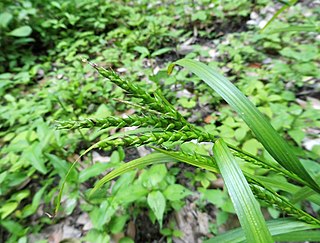
Saccharum is a genus of tall perennial plants of the broomsedge tribe within the grass family.

The Cyperaceae are a family of graminoid (grass-like), monocotyledonous flowering plants known as sedges. The family is large: botanists have described some 5,500 known species in about 90 genera, the largest being the "true sedges" with over 2,000 species.

Vigna is a genus of plants in the legume family, Fabaceae, with a pantropical distribution. It includes some well-known cultivated species, including many types of beans. Some are former members of the genus Phaseolus. According to Hortus Third, Vigna differs from Phaseolus in biochemistry and pollen structure, and in details of the style and stipules.
Ruellia multifolia is a species of flowering plant in the family Acanthaceae. It is a perennial or subshrub native to west-central, southern, and southeastern Brazil, northeastern Argentina, and Paraguay.

Uncinia is a genus of flowering plants in the family Cyperaceae, known as hook-sedges in Australia and as hook grasses or bastard grasses in New Zealand. The genus is characterised by the presence of a long hook formed by an extension of the rachilla, which is used to attach the fruit to passing animals (epizoochory), especially birds, and it is this feature which gives the genus its name, from the Latin uncinus, meaning a hook or barb.
Jisaburo Ohwi was Japanese botanist. He was a distinguished member of the Faculty of Science of Kyoto Imperial University. He is perhaps best known for his 1953 Flora of Japan.
Carex accrescens is a species of sedge that was first described by Jisaburo Ohwi in 1931. It is native to eastern Asia, from Siberia to the Korean Peninsula and Japan.

Carex autumnalis is a species of flowering plant in the sedge family, Cyperaceae. It was first formally named by Jisaburo Ohwi in 1930. Carex autumnalis is native to Japan and mainland eastern Asia, from southeastern China to North Korea. In China it grows in shady ravines.
Carex brachyanthera is a species of sedge that was first formally named by Jisaburo Ohwi in 1934. It is native to parts of eastern Asia and Oceania.

Carex lanceolata is a species of sedge, native to the eastern half of China, Mongolia, eastern Siberia, Korea, Sakhalin, and Japan. Its seeds are dispersed by ants.

Carex morrowii, the kan suge, Morrow's sedge, Japanese grass sedge or Japanese sedge, is a species of flowering plant in the family Cyperaceae. It is native to central and southern Japan, and has been introduced to Belgium, Denmark and Austria.

Carex kobomugi is a species of sedge, known as the Japanese sedge or Asiatic sand sedge, that lives in sandy coastal areas of eastern Asia, and has become an invasive species in the north-eastern United States.

Carex ischnostachya is an herbaceous graminoid plant in the sedge family (Cyperaceae). It is native to the eastern Asia, where it is found in China, Japan, and Korea. Its natural habitat is in forest openings in wet areas, in hills or mountains. It is a common species, and is often found along roadsides or trails.
Carex aphyllopus is a species of sedge. Its native range is Central Japan.

Carex dolichostachya is a species of flowering plant in the sedge genus Carex, family Cyperaceae. It is native to eastern Asia; central and southeast China, Taiwan, the Philippines, Korea, the Ryukyu Islands, and Japan. Its popular cultivar 'Kaga-nishiki' is sold in the US by the trade designation Gold Fountains.
Carex quadriflora, the four-flower sedge, is a species of flowering plant in the family Cyperaceae, native to northeastern China, the Russian Far East, the Korean Peninsula, and Japan. Its chromosome number is 2n = 46.
Carex graeffeana is a tussock-forming species of perennial sedge in the family Cyperaceae. It is native to parts of Malesia and islands of the south western Pacific Ocean.

Carex dissitiflora is a tussock-forming species of perennial sedge in the family Cyperaceae. It is native to parts of Japan and Taiwan.
Carex chinoi is a tussock-forming species of perennial sedge in the family Cyperaceae. It is native to parts of Japan.











